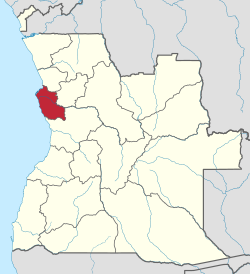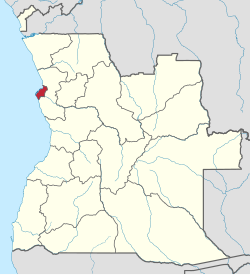Luanda Province
 From Wikipedia - Reading time: 8 min
From Wikipedia - Reading time: 8 min
Luanda | |
|---|---|
 | |
| Country | Angola |
| Capital | Luanda |
| Government | |
| • Governor | Manuel Homem[1] |
| • Vice-Governor for the Economic Sector | Lino Quienda Mateus Sebastião |
| • Vice-Governor for Technical Services and Infrastructures | Cristiano Mário Ndeitunga |
| • Vice-Governor for the Political and Social Sector | Dionísio Manuel da Fonseca |
| Area | |
• Total | 18,835 km2 (7,272 sq mi) |
| Population (2014 Census) | |
• Total | 6,945,386 |
• Estimate (2022) | 9,079,811 [2] |
| • Density | 370/km2 (960/sq mi) |
| ISO 3166 code | AO-LUA |
| HDI (2022) | 0.710[3] high · 1st of 18 |
| Website | www |
Luanda is a province of Angola. It covers an area of 18,835 km2, and had a population of 6,945,386 at the Census of 16 May 2014. The latest official estimate (for 2022) is 9,079,811.[4]
The city of Luanda is the capital of the province and Angola. It serves as the country's primary port, cultural and urban centre and occupies 44.8 square miles.[5]
History
[edit]
The original prewar Luanda Province grew in size during the 20th century due to the urbanization of Angola. It was divided into the provinces of Luanda and Bengo in 1980.[6][7]
The new reform of 2011 moved the municipalities Icolo e Bengo and Quiçama from Bengo to Luanda Province, so as the province has 3 neighboring ones instead of being surrounded by Bengo. The administrative reform significantly increased the land area of Luanda Province. It formerly had an area of 2,417 square kilometres (933 sq mi) and a reported population of 6,542,942 in 2014, before accounting for reorganization[2] Despite this, the city occupied 113 square kilometres (44 sq mi), or less than five percent of the total area of the former province.
Governors
[edit]Governors of the Luanda Province have included: Francisca Espírito Santo (c. 2009–2010),[8] Jose Maria dos Santos (c. 2011–2013), and Graciano Francisco Domingos (c. 2014).[citation needed]
Administration
[edit]The province has created the Instituto de Planeamento e Gestão Urbana de Luanda (IPGUL, Institute for urban planning and management of Luanda) as an independent organ for urban planning of the province.[9]
Municipalities
[edit]The province of Luanda contains seven municipalities (Portuguese: municípios):
| Name | Area in km2 |
Population Census 2014 |
Population Estimate 2019[4] |
|---|---|---|---|
| Belas | 1,046 | 1,071,046 | 1,271,854 |
| Cacuaco | 312 | 1,077,438 | 1,279,488 |
| Cazenga | 37 | 880,639 | 1,045,722 |
| Ícolo e Bengo | 3,059 | 110,428 | 131,268 |
| Luanda | 116 | 2,165,867 | 2,571,861 |
| Quiçama | 13,900 | 39,373 | 46,808 |
| Viana | 693 | 1,600,594 | 1,900,688 |
In 2011 Luanda Province was subdivided into seven municipalities, namely, Luanda, Belas, Cacuaco, Cazenga, Icolo e Bengo, Quiçama and Viana.[10][6] In November 2016, another two municipalities were added, Talatona and Kilamba-Kiaxi respectively, giving the province 9 municipalities, 41 urban districts, and 14 communes.[11]
Communes
[edit]The province of Luanda contains the following communes (Portuguese: comunas); sorted by their respective municipalities:
- Belas Municipality: – Barra do Cuanza, Quilamba (Kilamba); Benfica e Mussulo, Ramiros
- Cacuaco Municipality: – Cacuaco, Funda, Quicolo (Kikolo)
- Cazenga Municipality: – Cazenga, Hoji Ya Henda, Tala Hady; Cazenga Popular, Distrito Industrial
- Ícolo e Bengo Municipality: – Bom Jesus do Cuanza, Cabiri (Kabiri), Caculo Cahango, Calomboloca (seat: Cassoneca), Catete
- Luanda Municipality: – Angola Quiluanje, Ingombota, Maianga, Rangel, Samba, Sambizanga
- Quiçama Municipality: – Cabo Ledo, Demba Chio, Mumbondo, Muxima, Quixinje (Kixinje)
- Viana Municipality: – Calumbo, Viana, Zango, Mbaia
- Kilamba-Kiaxi Municipality: – Quilamba-Quiaxi (Kilamba-Kiaxi); Golfe, Palanca, Sapú, Vila Estoril
- Talatona Municipality: – Benfica, Talatona; Camama, Futungo de Belas, Quificas
List of governors of Luanda
[edit]| Name | Years in office |
|---|---|
| Pedro Fortunato Luís Manuel | 1976–1977 |
| Afonso Van-Dunem Mbinda | 1977–1978 |
| Agostinho André Mendes de Carvalho | 1979–1980 |
| Francisco Romão de Oliveira e Silva | 1980–1981 |
| Evaristo Domingos Kimba | 1981–1983 |
| Mariano da Costa Garcia de Puku | 1983–1986 |
| Cristovão Francisco da Cunha | 1986–1988 |
| Luís Gonzaga Wawuty | 1988–1991 |
| Kundi Paihama | 1991–1993 |
| Rui Óscar de Carvalho | 1993–1994 |
| Justino José Fernandes | 1994–1997 |
| José Aníbal Lopes Rocha | 1997–2002 |
| Simão Mateus Paulo | 2002–2004 |
| Job Pedro Castelo Capapinha | 2004–2008 |
| Francisca do Espírito Santos | 2008–2010 |
| José Maria Ferraz dos Santos | 2010–2011 |
| Bento Joaquim Sebastião Francisco Bento | 2012–2014 |
| Graciano Francisco Domingos | 2015–2016 |
| Francisco Higino Lopes Carneiro | 2016–2017 |
| Adriano Mendes de Carvalho | 2017–2019 |
| Sérgio Luther Rescova Joaquim | 2019–2020 |
| Joana Lina | 2020-2021 |
| Ana Paula de Carvalho | 2021-2022 |
| Manuel Homem | 2022-present |
Up to 1991, the official name was Provincial Commissioner
References
[edit]- ^ "Governador - Biografia de Manuel Gomes Da Conceição Homem". governo.gov.ao. Retrieved 2023-09-23.
- ^ a b http://citypopulation.de/php/angola-admin.php via Instituto Nacional de Estatístiica, República de Angola (web)
- ^ "Sub-national HDI - Area Database - Global Data Lab". hdi.globaldatalab.org. Retrieved 2018-09-13.
- ^ a b Instituto Nacional de Estatístiica, República de Angola.
- ^ World's Capital Cities. "Capital Facts for Luanda, Angola". worldscapitalcities.com. Retrieved 23 April 2019.
- ^ a b National Assembly of Angola (27 July 2011). "Lei n.º 29/11 de 1 de Setembro - Alteração da Divisão Político-Administrativa das províncias de Luanda e Bengo" [Law to change the politico-administrative divisions of Luanda and Bengo provinces] (PDF) (in Portuguese). IPGUL 'Noticias'. Retrieved 20 March 2012. While the law had been voted on July 27, 2011, its effective date is 60 days after publication in the Official Journal, which happened on September 1, 2011.
- ^ Broadhead, Susan (1992). Historical dictionary of Angola. Metuchen, N.J: Scarecrow Press. p. 119. ISBN 0585070091.
- ^ "Perfil do Governador". Governo Provincial de Luanda (in Portuguese). Governo da República de Angola.[dead link]
- ^ "Informação sobre o IPGUL" [Information about the IGPUL] (in Portuguese). Retrieved 20 March 2012.
- ^ "Luanda" (in Portuguese). Luanda, Angola: Info-Angola. 2013. Archived from the original on 6 November 2013. Retrieved 26 December 2013.
- ^ "Luanda passa a ter nove municípios". 29 November 2016.
- ^ "Histórico dos Governadores" (in Portuguese). luanda.gov.ao. Retrieved 6 Mar 2019.
External links
[edit]- Official Governor of Luanda Province website
- Alternate official Luanda Province government website—(in Portuguese)
- Geoview.info: Luanda Province geography info
- Angolan ministry for territorial administration: Luanda Province
- IPGUL.org: Administrative map of Luanda Province with mapping those to old divisions
- Official City of Luanda website—(in Portuguese)
- Info Angola.ao: Luanda Province information
 KSF
KSF